Banele Khoza is a visual artist who also writes poetry. In his most recent series of paintings he challenges the concept of masculinity and reflects on issues related to romantic and erotic love. In this conversation, the artist briefly discusses his new solo exhibition at Absa Art Gallery, Johannesburg, titled Seeking Love, 50-60 pieces depicting colorful and intense portraits of males and vivid emotions—sometimes with a sardonic twist.

Banele Khoza, (left) Watching You, Gouache on Paper, 2019. 42,5cm x 30,4cm (right) Warhol still 1, 2018. Acrylic and ink on linen canvas, 60cm x 81cm. Courtesy the artist.
Contemporary And: Your upcoming solo exhibition titled Seeking Love is a reflection of where you are and have been emotionally lately. How did you develop the concept for the new show?
Banele Khoza: When I came up with the show LOVE? I had hoped it would be simply titled LOVE because I was hoping to be in love during that period. However, I was questioning the relationship I was in. My now ex-partner and I separated a month after he saw the show. When working on Seeking Love, I was actively seeking love from people and in certain places. I am someone who believes in hard work and I have worked hard at trying to find love. I have experienced the promise of romantic love for ten years and I am now practicing, but haven’t been lucky in that department compared to my friends and family. The show really captures a journey beyond what will be presented. Despite showing works from the past year, this body of work reflects the spirit of a life’s journey. Love is eternal. Love always broods.
C&: In your most recent series of paintings you haven’t waived the practice of using frank confessions in the form of text intervention on the canvas, like in the piece Fragile.
BK: I treat every surface—canvas, paper, any structure, including social media platforms —like a diary. I always try to be honest with (mainly) myself and the next person. Fragile captures who I am as an individual and is a warning message to the next person. It is painted in blue because this is the color society imposes for boys, while pink is set for girls. This piece acknowledges fragile masculinity. Actually, pink also happens to be my favorite color—irony lies in the details.
Here I want to share a few lines of a poem that I wrote at 3 a.m. in the morning. The words came as a thread. Hadn’t I grabbed my laptop and written them down, I would have lost them:
Yesterday I allowed myself to dream…
For the last time
This is how it was supposed to end…
We realized that we were each other’s missing limb
Whole souls complimenting each other
We speak the same language, we fear the same
Yet we are trying to face our fears together
I look into your eyes and remember youth, middle age, now and heaven
One step at a time
This is how it ends
Unwritten
My dream remains in the conscious
Unarchived in the book of dreams
God laughs

Banele Khoza, The Heart Knows Better Than the Mind, 2019. Acrylic and Acrylic ink, on Canvas, 60cm x 45cm. Courtesy the artist.
C&: You depict colorful and intense portraits of males, with your primary medium—often acrylics—interceding on the canvas as if it were watercolor. Can you help us understand the painting process?
BK: The painting process begins with me gathering all the colors available in the studio, as the first task is to disrupt the white surface of the structure and I believe the colors heighten the identity of each piece . I normally lay out a lot of canvases—more than 20 at one point—to approach the whole process with ease. The colors I drift to are a response to my mood or feelings at that particular moment. I also break the medium with water to find a new application that resonates with me. I am obsessed with fluidity but I also like the sense of strength that gouache or acrylic offer on canvas.
C&: You like to add a sardonic twist to your artworks. Does this arise from your attitude to life?
BK: It is the way in which I appropriate the creative process. I always try to keep my feet on the ground. In the end, whether the artwork is successful or not, I have to confront reality. This is when there is sometimes a twist in the plot, it is when I acknowledge both ends, my projection and what the work actually is.

Banele Khoza, I Thought I Had Met My Soul Mate, 2019. Acrylic Ink and Charcoal, on Paper, 98cm x 107cm. Courtesy the artist.
C&: You have launched an art gallery of your own in Braamfontein, in Johannesburg, where your studio is also based. How are artists responding?
BK: The opening of a studio-gallery has been the best decision I have ever made, both for my creativity and life. I like saying that this space helps to heal the wounds that many old and young souls have suffered in their lives. It embodies the concept of making it possible, and I am happy to be at its service. Artists that I have looked up to in my formative years also wish to collaborate, and this moves me because I had never imagined that this could happen.
C&: And what’s coming up next?
BK: I am conceptualizing a solo exhibition at the Pretoria Art Museum that will open with blank canvases and then have a closing ceremony. I will turn the space into my living and working place for two months. Then there will be a body of work to exhibit. Seeking Love will also be travelling to new spaces I haven’t exhibited at in South Africa: Durban, Port Elizabeth, Bloemfontein, and Stellenbosch
Seeking Love is on show at Absa Art Gallery in Johannesburg until April 26th.
Banele Khoza (*1994) is a Swaziland-born, South Africa-based visual artist. He firstly enrolled at the London International School of Fashion in Johannesburg, but soon realized his passion was drawing. Khoza holds a BTech in Fine Arts from Tshwane University of Technology, Pretoria. In 2017 he won the prestigious Gerard Sekoto Award and with it a three-month residency at the Cité Internationale des Arts in Paris. His solo exhibitions include Temporary Feelings at the Pretoria Art Museum (2016); Lonely Nights at Lizamore Gallery (2017), LOVE? at Smith Studio in Cape Town (2018). Khoza also headlined the solo exhibition titled LGBTQI+: Banele Khoza as part of the Curatorial Lab at Zeitz MOCAA (2018). In 2018 he curated A Letter to my 22 Year Old Self, a group show presented to launch his fundraising activities which will give grants to art students dealing with economic hardship at SA universities. www.bkhz.co.za
Elisa Pierandrei is a journalist based in Milan.
More Editorial